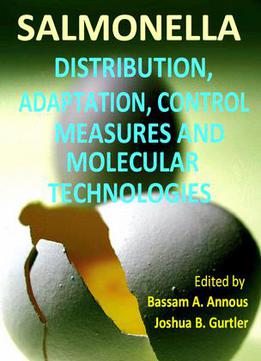
Salmonella: Distribution, Adaptation, Control Measures And Molecular Technologies Ed. By Bassam A. Annous, Joshua B. Gurtler
by Bassam A. Annous /
2012 / English / PDF
157.9 MB Download
This work represents the collective contributions of authors from all around the world. Chapters in this book address a wide array of topics related to understanding and controlling this pathogen, including: Salmonella as studied in the environment, air and in food products; virulence and pathogenicity; control by bacteriophages and other antimicrobials; bacterial adaptation.
The discovery of Salmonella in swine in 1885 marked the beginning of intense efforts to control salmonellae that have continued for the past 127 years. The majority of foodborne outbreaks are caused by only a few of the 2500+ known serovars. While progress has been made on many fronts, salmonellosis has yet to be eliminated in either developed or in developing nations.
Preface
1 Elucidating the Epidemiology of Human Salmonellosis: The Value of Systematic Laboratory Characterisation of Isolates
2 Salmonellae in the Environment
3 Prevalence. Detection and Antimicrobial Resistance Pattern of Salmonella in Sudan
4 Salmonella Associated with Snakes (Suborder Serpentes)
5 Salmonella Control Measures at Farm in Swine Production
6 Adaptation of Salmonella to Antimicrobials in Food-Processing Environments
7 Influence of Trisodium Phosphate on the Survival of Salmonella on Turkey Carcasses
8 Bacteriophage PPST1 Isolated from Hospital Wastewater. A Potential Therapeutic Agent Against Drug Resistant Salmonella enterica subsp. enterica serovarTyphi
9 The Seasonal Fluctuation of the Antimicrobial Activity of Some Macroalgae Collected from Alexandria Coast, Egypt
10 The Role of Proteomics in Elucidating Multiple Antibiotic Resistance in Salmonella and in Novel Antibacterial Discovery
11 Use of Integrated Studies to Elucidate Potential Benefits from Genetic Resistance to Salmonella Carrier State in Fowl
12 16S rRNAMethyltransferases: An Emerging Resistance Mechanism Against Aminoglycosides in Salmonella
13 The Phosphoinositides: Key Regulators of Salmonella Containing Vacuole fSCV) Trafficking and Identity
14 Searching for Outer Membrane Proteins Typical of Serum-Sensitive and Serum-Resistant Phenotypes of Salmonella
15 Virulence Characterization of Salmonella Typhimurium l.4.[5],12:i:-, the New Pandemic Strain
16 Salmonella: Invasion. Evasion & Persistence
17 The Different Strategies Used by Salmonella to Invade Host Cells
18 A Tale of 6 Sigmas: How Changing Partners Allows Salmonella to Thrive in the Best of Times and Survive the Worst of Times
19 Assembly and Activation of the MotA/B Proton Channel Complex of the Proton-Driven Flagellar Motor of Salmonella enterica
20 Molecular Armory of S. Typhi: Deciphering the Putative Arsenal of Our Enemy
21 Molecular Diagnosis of Enteric Fever: Progress and Perspectives
22 Comprehending a Molecular Conundrum: Functional Studies of Ribosomal Protein Mutants from Salmonella enterica Serovar Typhimurium
23 Molecular Technologies for Salmonella Detection











